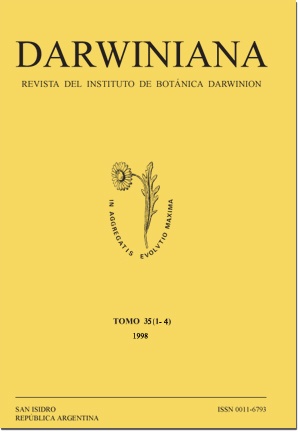Leaf architecture of three South American monotipic genera of Fabaceae
DOI:
https://doi.org/10.14522/darwiniana.2014.351-4.387Keywords:
Foliar architecture, Tipuana, Cascaronia, Bergeronia, FabaceaeAbstract
The leaf architecture of Tipuana Benth., Cascaronia Griseb. and Bergeronia Micheli, is described and compared, evaluating the importance of these foliar characters in their taxonomy. Each genus presents characters that allow their differentiation: in Tipuana tipu (Benth.) Kuntze, the basal pairs of secondary veins have an eucamptodromous model, with simple intersecondary veins which move through the intercostal area towards the margin; the last marginal venation is looped. In Cascaronia astragalina Griseb., secondary veins have capillary thickness and the last marginal venation is incomplete. In Bergeronia sericea Micheli, there are abaxial prominent secondary véins, and tertiary veins emerging in rigth angles; the last marginal venation is fimbrated. The venation characters observed are similar to those previously cited for different genera of Dalbergieae and some cited in other tribes of Papilionoideae. However, they cannot define, for themselves, the taxonomic position of the three genera and must be considered together with other morphological and reproductive structures.Downloads
Published
31-12-2011
How to Cite
Malla, L. M., Gallego, L., Villamil, S., & Mújica, M. B. (2011). Leaf architecture of three South American monotipic genera of Fabaceae. Darwiniana, Nueva Serie, 35(1-4), 1–8. https://doi.org/10.14522/darwiniana.2014.351-4.387
Issue
Section
Anatomy and Morphology
License

Starting on 2012, Darwiniana Nueva Serie uses Licencia Creative Commons Atribución-NoComercial 2.5 Argentina .






